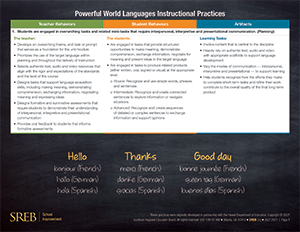Powerful World Languages Instructional Practices
 This quick-reference guide presents
examples of teacher and student behaviors and learning artifacts
found in classrooms that adopt six Powerful World
Languages Instructional Practices. Teachers who adopt
these practices in their classrooms create rich and varied
opportunities for students to develop the language acquisition
skills that are essential to spoken, written or signed
cross-cultural communication and understanding.
This quick-reference guide presents
examples of teacher and student behaviors and learning artifacts
found in classrooms that adopt six Powerful World
Languages Instructional Practices. Teachers who adopt
these practices in their classrooms create rich and varied
opportunities for students to develop the language acquisition
skills that are essential to spoken, written or signed
cross-cultural communication and understanding.
- Students are engaged in overarching tasks and related
mini-tasks that require interpersonal, interpretive and
presentational communication. (Planning)
- The lesson sequence supports or scaffolds learning, enabling
students to connect other disciplines and previous knowledge to
acquire information and diverse perspectives.
(Planning)
- Clear and measurable learning targets based on language
standards are communicated to students and aligned with formative
and summative assessments. (Instruction)
- Learning strategies support knowledge and skill acquisition
while allowing students to draw comparisons and develop insights
into the nature of language and culture.
(Instruction)
- Student discourse is used daily as a part of the learning
cycle to reinforce communities both within and beyond the
classroom that promote lifelong learning.
(Instruction)
- Classroom activities provide students opportunities to explore and reflect the relationship between practices, products and perspectives of other cultures. (Instruction)

